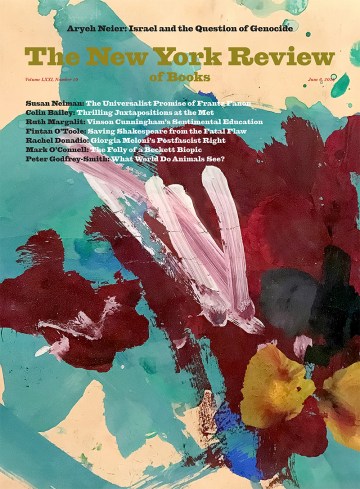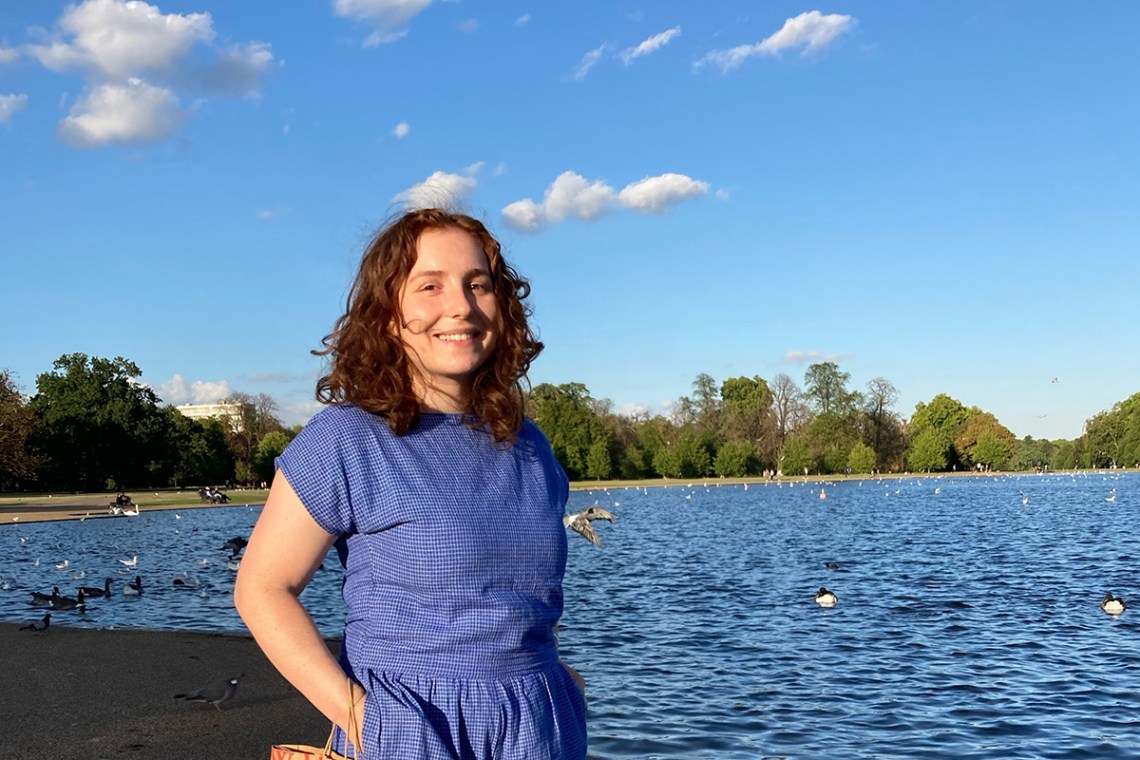This article is part of a regular series of conversations with the Review’s contributors; read past ones here and sign up for our e-mail newsletter to get them delivered to your inbox each week.
Even the smallest gestures—a tilt of the wrist, a tap of the toe—seem to rumble from deep within. Her performance has the feel of a private rehearsal or a practiced ritual. Seated in the front row, at times within arm’s reach of her, I refrain from even the most discreet note-taking, not wanting to break whatever trance she’s in. But the trance pulls me in, too. She moves like a perpetual motion machine, without friction or inertia.
For four nights at Brooklyn’s Roulette Intermedium this winter, the sixty-nine-year-old choreographer Molissa Fenley and a small company performed a program of new and recent dances. In the NYR Online Erica Getto writes about Fenley’s life and career, which over five decades has drawn inspiration from an eclectic range of sources—flamenco, Nijinsky, New York’s downtown dance scene, ornate Italian mosaics—while maintaining a fierce independence “marked by a kinetic, spry athleticism” and “a preoccupation with the lone artist and the company she keeps.”
In addition to her dance criticism—alongside essays about Trisha Brown, Yvonne Rainer, and Pam Tanowitz for The New York Review, her work has appeared in The Brooklyn Rail and BOMB Magazine—Getto works as a television and podcast producer. She most recently served as executive producer of the podcast Getting Curious and has worked on series for Netflix, NBCUniversal, and Comedy Central. This week I e-mailed her to ask about what audiences should look for in a dance and how to take notes during a live performance.
Daniel Drake: When did you first hear about Molissa Fenley? What was the first performance of hers, either recorded or live, that you saw?
Erica Getto: I’d been familiar with her work for years, but what I love about an assignment of this length and scope is that it gives me a chance to really sit with a dancer’s sensibility. Fenley is an ideal subject: she’s been dancing and choreographing new work for over half a century, there’s been consistent writing about her solo career and her company, and she has meticulously cataloged her performances.
I looked back at my notes for this piece, and it seems that I was initially drawn to a recording of a group dance that I don’t mention: Amdo (Water Table, Part 7) (2016). In the fifteen-minute performance, seven dancers wearing blue jumpsuits make just about all the moves that I now understand to be characteristic of a Fenley performance: they drift in and out of sync, they partner and uncouple, they cross from one wing or edge of the stage to another in undulating patterns, they fleetingly form a circle at center stage. Sturdy legs allow them to nimbly and gracefully extend their arms to full wingspan.
These motifs befit a dance titled after the fragile geologic boundary where water and atmospheric pressure are equal. But they recur throughout the more than one hundred videos that Fenley has graciously uploaded to Vimeo—and in many of these dances they take on a slippery, haunting quality that transfixed me. Rhythm Field, a collection of writing on Fenley’s work, is also full of spectral figures, like Nijinsky and Stravinsky and the “ghosts of sculpture” who consumed her during a 2008 trip to Italy. And then there’s the horror of her injury on stage in 1995—a split second that could have ended her career instead became an inflection point. But the threat of collapse still lingers.
How did you come to dance criticism in the first place? Do you have a dance background?
I used to reflexively tell people that I didn’t have a dance background because I didn’t grow up at a ballet barre. But I have a third-degree black belt in taekwondo, and I competed in the sport at an elite level for over a decade. Only recently did it occur to me that my taekwondo training does qualify as dance training—it’s a movement-based practice that is sometimes choreographed, sometimes improvised.
I turned to dance history and criticism in my last year as an undergraduate at Columbia. I had spent three years cobbling together an American Studies major with any course that had “New York City” in the title or description. (I spent the rest of my time at the campus radio station WKCR, where the current students’ valiant ongoing coverage of the Gaza solidarity protests makes me very proud.) I came across a social dance history course taught by Seth Stewart Williams, then a course on dance in New York City taught by Siobhan Burke. Both got me out of the classroom and into venues like Judson Memorial Church and the Joyce Theater; both challenged me to find language to describe a time- and movement-based art form.
I’m very grateful to Siobhan for encouraging me to write about dance after graduation, because it’s something I’d never considered; I’d long been intent on working in the entertainment industry. I ended up doing both, and I found that the two pursuits overlap. In my work as an audio producer, for instance, I’m constantly thinking about how to describe in words what’s not available in images, and the same can be said for my dance writing. How do I capture what happened—and what moved me—during a performance that most of my readers will never have a chance to see?
Advertisement
We spoke during the editing process for this piece about what verb tense to use when describing Fenley’s recent program at Roulette. I suggested that those paragraphs appear in the present tense for this very reason. I never want readers to feel like I’m recounting a “you had to be there” moment; instead, I want them to feel like a given dance is playing out anew on the page.
What are you looking for when you watch a performance? What kind of notes do you take?
My note-taking method has evolved over the years. I used to aim for comprehensiveness, a task that is at once unachievable and risks resulting in a plodding, descriptive piece. Now, I seek out subjects about whom I can do a great deal of research before taking my seat at the performance—that way, I’m primed and ready to look for patterns in the program and to be surprised by deviations from those patterns.
I like to jot down moments that I likely won’t be able to check or remember later—say, where performers are on the stage during a critical moment, or how and when two dancers share a smile. I also “live write” certain impressions that I know I’ll want to include in my piece. For Fenley’s Roulette show, I was keen to track what the critic Sally Banes called the “perceptual afterimages” in her choreography, and to get a feel for the relationship between the solo and group dances. I couldn’t have anticipated how it would feel to witness the fluidity and intensity of Fenley’s solo in Current Piece #1; as I admit in the review, I didn’t take any notes on it.
Here are some other things I pay attention to: first, how are the performers arranged in relation to the audience, to the edges of the stage, and to one another? For instance, Pam Tanowitz and Trisha Brown, both of whom I’ve written about for the NYR Online, have dances that regularly hover on the wings of a proscenium stage.
Second, what shapes are the dancers forming with their bodies? In Fenley’s work, you can often trace triangles and trapezoids with the lines their bodies make. If you wanted, you could sit through a choreographer’s season and focus on a different body part every night. I’m partial to tracking hands, which can be so expressive—see Yvonne Rainer’s Hand Movie (1966), for example.
Finally, how do the dancers interact with any music, if they interact with it at all? In edits, we talked about the fact that Fenley choreographs to the beat and mood of a given piece of music but that this isn’t the norm for all choreographers—Merce Cunningham, for instance, would choreograph his dances independently from the music with which they were ultimately paired; his performers might hear that music for the first time the moment they stepped on stage.
Who are some of your favorite contemporary dancers? Who should I go see next in my continuing education in the dance world?
I’d love to highlight the dancer and choreographer Lloyd Knight. (You can see his and others’ entire State of Darkness performances on the Joyce website.) I remember the first time that I saw Knight dance—I was attending the Martha Graham Dance Company’s Joyce season in college, and I was so struck by his exuberance and poise on stage.
We’ve just missed the company’s latest “GrahamDeconstructed” event, but I’ve long enjoyed that series; the May 2 installment took attendees behind the scenes of Appalachian Spring (1944) with a mix of live performance and commentary. Another performance-based studio series that I’d recommend is Cathy Weis’s “Sundays on Broadway”; their next two events are on May 12 and May 19, and they always have a great lineup of contemporary and experimental dancers, choreographers, and artists.
From May 8 to June 27, Anthology Film Archives will also be spotlighting the work of Charles Atlas, whose dance films feature some of my favorite choreographers and performers: Michael Clark, Karole Armitage, Rainer, and Cunningham. Come for Hail the New Puritan; stay for As Seen on TV. And while we’re talking about dance on camera, the brilliant choreographer and filmmaker Sarah Friedland is showing three of her movement-based films at The Bronx Museum Biennial now through June 16.
Advertisement
Who are some of your favorite dance critics?
The critic Jill Johnston, who reviewed the Judson Dance Theater concerts in the 1960s, saw her performance writing as a form of recordkeeping. Even in a moment when dance can be livestreamed around the world, I approach my work in the same way; it’s a form of bearing witness, especially for engagements that have limited runs at smaller venues. On this score I think The Brooklyn Rail in particular does a fantastic job.
Another important critic to me is the late Sally Banes, who built on Johnston’s Judson writing. In her book Writing Dancing in the Age of Postmodernism, Banes has an essay called “On Your Fingertips: Writing Dance Criticism.” I think it sums up the task of the dance writer well. Building on the writing of Edwin Denby, who himself was “paraphrasing Goethe on theater criticism,” she encourages
description (what the dancers did—what does the work look and feel like?); interpretation (what they communicated—what does the dance mean?); and evaluation (how remarkable it was—is the work good?). To Denby’s list I would add another critical operation: contextual explanation (where does the work come from aesthetically and/or historically?).
I find great joy in seeing live dance precisely because it’s an ephemeral art form. Whenever I attend a one-off event like the Beach Sessions Dance Series, I feel such gratitude for sharing that stretch of time and space with the dancers and everyone else in attendance. It’s worth noting that we were able to witness Fenley’s Roulette performance together, and for that I am very glad.



